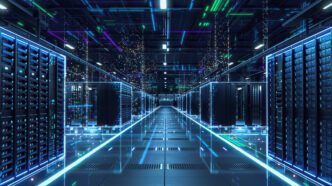The growing demand for artificial intelligence (AI) technologies is rapidly pushing the limits of AI data centers infrastructure. According to a recent study by Georgetown University, Epoch AI, and Rand, data centers required to train and operate AI systems could soon be housing millions of chips, costing hundreds of billions of dollars, and consuming electricity equivalent to the power grid of a large city.
The study, which analyzed over 500 AI data center projects globally, reveals that the computational performance of these centers is more than doubling annually, along with a steep rise in both power requirements and capital expenditures. This growing trend presents significant challenges in meeting the infrastructure needs for AI advancements in the coming decade.
The findings indicate that the hardware costs of AI data centers, such as xAI’s Colossus, are projected to increase 1.9 times each year from 2019 to 2025. Colossus, which has an estimated $7 billion price tag, is one example of the rapidly escalating cost of AI infrastructure. Power demands are also on the rise, with the energy needs of AI data centers climbing at a rate of 2x annually between 2019 and 2025.
To put this into perspective, Colossus alone requires an estimated 300 megawatts of power—enough to power approximately 250,000 households. As AI technologies continue to develop, the energy requirements are set to grow exponentially. The study predicts that by June 2030, the leading AI data centers may be operating with up to 2 million AI chips, costing around $200 billion, and consuming 9 gigawatts (GW) of power—equivalent to the output of nine nuclear reactors.
The Environmental Toll of AI Data Centers
While AI data centers have become more energy efficient over the past five years—thanks to advancements in computational performance per watt (which has increased by 1.34 times annually from 2019 to 2025)—these improvements will not be sufficient to offset the escalating power needs. This spells trouble for global power grids, as AI data center energy consumption is forecast to grow by 20% by 2030, according to a recent analysis by Wells Fargo.
The growing electricity demands of AI data centers are poised to put immense pressure on power grids worldwide, especially as renewable energy sources, which are dependent on weather patterns, may struggle to keep up. This may lead to a heavy reliance on non-renewable, environmentally damaging energy sources, such as fossil fuels, to meet the power demands.
In addition to high energy consumption, AI data centers also pose other environmental challenges, such as significant water usage and the occupation of valuable real estate. A study by Good Jobs First, a nonprofit organization based in Washington, D.C., revealed that AI data centers contribute to a loss in state tax revenue, with at least 10 states losing over $100 million per year due to tax incentives granted to these facilities.
The Financial Burden on the Industry
The study also explores the financial burden of AI data centers, which require staggering investments. OpenAI, for example, has partnered with SoftBank and other companies to raise up to $500 billion to build a network of AI data centers in the U.S. and potentially elsewhere. In addition, tech giants such as Microsoft, Google, and Amazon Web Services (AWS) have committed to spending hundreds of millions of dollars this year to expand their data center operations.
However, the study suggests that the rapid growth of AI data centers may not continue at the same pace. In recent weeks, some hyperscalers, including AWS and Microsoft, have scaled back on their data center projects. Analysts at Cowen noted a “cooling” of the data center market in early 2025, signaling concerns over the unsustainable expansion of the industry.
As AI technologies continue to advance, the demand for data centers to support them will only increase. While investment in AI infrastructure is necessary to drive innovation, it’s crucial for the industry to consider the environmental and financial implications of such rapid growth. The ongoing challenge will be finding a balance between expanding AI capabilities and ensuring that infrastructure development is sustainable, both financially and environmentally.
AI data centers are poised for explosive growth, requiring billions of dollars in investment and an immense amount of power. While advancements in energy efficiency may alleviate some pressure, the environmental impact of these data centers cannot be ignored. As the industry grapples with these challenges, it will be essential to explore innovative solutions for meeting the demand for AI infrastructure without compromising on sustainability.













